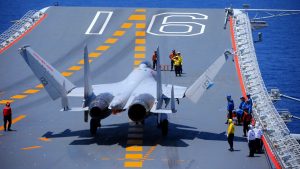A major Shanghai shipyard is being significantly expanded amid news that work has begun there on China’s fourth aircraft carrier.
The South China Morning Post (SCMP) reports that the Jiangnan shipyard is beginning a three-year expansion that will include a new ship design and research center, additional workshops, fabrication facilities, quays, and other shipbuilding infrastructure. Some of the new shipyard will support the yard’s commercial vessel work but much appears to be focused on the aircraft carrier building program of the People’s Liberation Army Navy (PLAN).
China’s first aircraft carrier, the Type 001 Liaoning, was rebuilt on a gutted, unfinished Ukrainian aircraft carrier hull and might be considered a modernized variant of the Soviet Kuznetsov-class carrier. China built an improved version of the Liaoning, designated the Type 001A, which it named the Shandong.
PLAN’s third and fourth carriers will be an entirely new design called the Type 002. They are expected to be much larger than the Liaoning and Shandong, and unlike those ships, which use ramps to assist planes in take-off, are reported to feature electromagnetic catapults.
Catapult-equipped ships can launch larger, heavier aircraft, and those aircraft use less fuel in take-off so they can carry more weapons and can fly longer and farther before needing to return. Most U.S. Navy aircraft carriers utilize steam-driven catapults. The new Ford-class carriers feature electromagnetic catapults, which are stronger and more efficient than steam.
SCMP also reports that assembly of the first Type 002 will be completed in the first half of this year and that construction of the second is in its early stages. Even though assembly could soon be finished, the Type 002 may not to be ready for operational service until mid-decade. Full outfitting and sea trials could take a year or more, and then its crew will have to train and certify the ship, which is likely to take longer because it is a new design and fitted with new technology.
Some observers describe this new progress as an acceleration of China’s naval shipbuilding plans, despite reports that construction was hitting roadblocks and tight budgets were forcing PLAN to scale back its ambitions. But so far this progress aligns with reporting from a year ago that the two planned Type 002 carriers would be completed, but plans for a fifth carrier of a new design, the Type 003, were being put on hold.
Reports of technical difficulties with the Type 002s does not preclude the ships from being assembled, but it could mean that their final fitting-out and sea trials will take much longer than expected to complete.
The U.S. Navy’s USS Gerald R. Ford faced similar “first-in-class” technical hurdles. After the ship was launched in 2013, it was not commissioned by the Navy until 2017 after lengthy repairs and rework required by the ship’s untested technology were completed. The ship’s first planned deployment has shifted from 2018 to 2020, to now possibly being ready in 2022.
The Type 003 design is especially challenging because it is expected to be PLAN’s first nuclear-powered surface ship. The expanding Jiangnan shipyard might signal optimism in the Type 003’s design but if not, China could opt to build a third Type 002. If the Type 003 is completed, the PLAN will have four significantly different carrier designs, which will create a major logistical and maintenance challenge to keeping its carrier fleet operating.
To help alleviate that maintenance burden, work appears to be nearly complete on a new, giant dry dock and repair yard on Hainan Island in the South China Sea that will be large enough to accommodate the Type 002 and Type 003 carriers.
If the carriers are completed, PLAN’s next challenge will be training a sufficient cadre of new pilots and crew to operate the giant new vessels. It will also have to overcome persistent challenges in the design and manufacture of a next-generation jet fighter to take full advantage of the Type 002’s catapult capability.
































